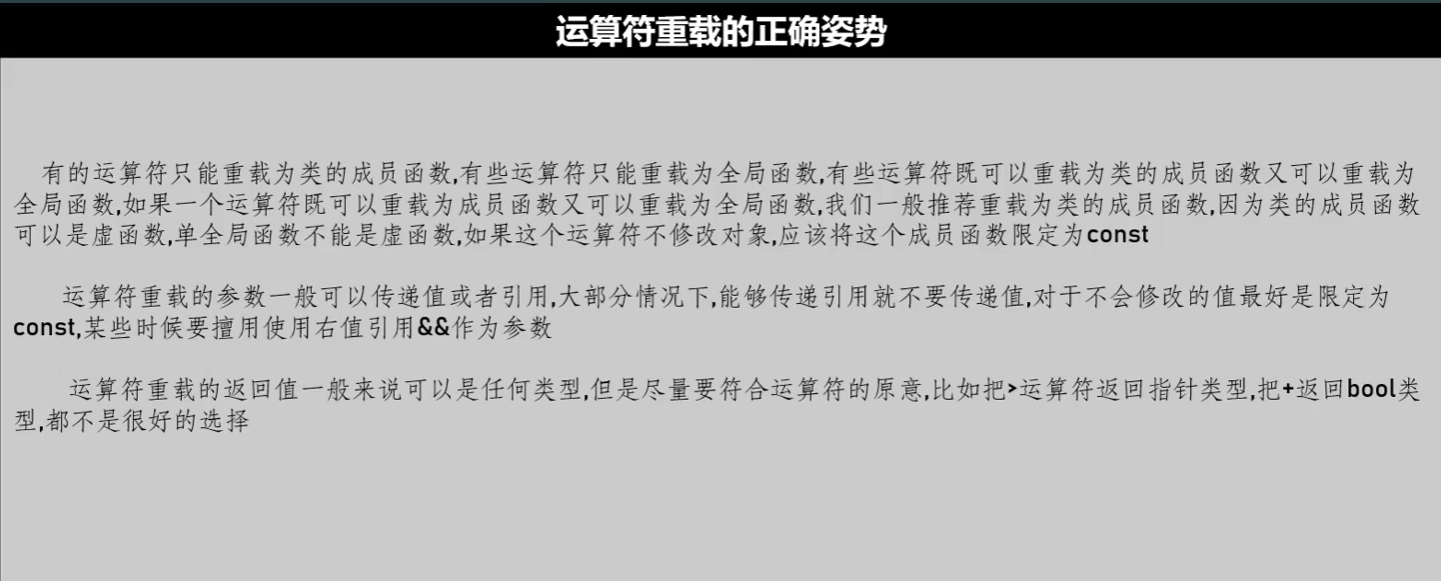运算符重载的主要目的是为了让目标代码更方便使用和维护,而不是提升开发效率,重载运算符未必能提升开发效率。
① 让类也支持原生的运算 比如 + - * /
② 提升对程序的控制权 比如重载new delete new[] delete[]
它允许你为自定义类型(如类或结构体)定义操作符的行为,使得这些操作符可以像内建类型一样工作。通过重载运算符,可以使自定义对象之间的运算更加直观和简洁。运算符重载是通过定义特殊的成员函数或友元函数来实现的
初探运算符重载
1
2
3
4
5
6
7
8
9
10
11
12
13
14
15
16
17
18
19
20
21
22
23
24
25
26
27
28
29
30
31
32
33
34
35
36
37
38
39
40
41
42
43
44
45
46
47
48
49
50
| #include <iostream>
class Person
{
friend bool operator<(Person& psa, Person& psb);
friend bool operator<(Person& psa, unsigned short _Age);
unsigned short Age;
public:
Person(unsigned short _Age) :Age{ _Age }{}
unsigned short GetAge() { return Age; }
bool operator>(Person& person);
};
bool Person::operator>(Person & person)
{
return Age > person.Age;
}
bool operator<(Person& psa, Person& psb)
{
return psa.GetAge() < psb.Age;
}
bool operator<(Person& psa, unsigned short _Age)
{
return psa.Age < _Age;
}
int main()
{
Person Man(20);
Person Woman(50);
if (Man>Woman) std::cout << " 你找到富婆了!!" << std::endl;
if (Man < 10) std::cout << " 你找到富婆了!!" << std::endl;
if (Man<Woman) std::cout << " 你找到富婆了!!" << std::endl;
}
|
!!!记住理解那些等价关系
运算符重载的原则和时机

不能把加法重载为减法!!!



传递值或者传递引用 建议传递引用 尤其是右值引用,不修改在前面加上const 就可以了
重载赋值运算符
默认赋值运算符重载
1
2
3
4
5
6
7
8
9
10
11
12
13
14
15
16
17
18
19
|
class Role
{
public:
int hp;
int mp;
Role& operator=(const Role& role);
{
hp = role.hp;
mp = role.mp;
return *this;
}
};
|
实现赋值运算符的重载
!!!operator=只能用类的成员函数来实现
1
2
3
4
5
6
7
8
9
10
11
12
13
14
15
16
17
18
19
20
21
22
23
24
25
26
27
28
29
| #include <iostream>
class Role
{
public:
int hp;
int mp;
Role& operator=(const Role& role);
};
Role& Role::operator=(const Role& role)
{
hp = role.hp;
mp = role.mp;
return *this;
}
int main()
{
Role x, y;
x.hp = 100;
y.mp = 200;
y = x;
}
|
当类里面有指针的时候,往往不能采用默认运算符,必须重载(例子如下)
1
2
3
4
5
6
7
8
9
10
11
12
13
14
| int main()
{
Role x, y, z;
x.hp = 100;
y.mp = 200;
z = y =x;
std::cout << y.hp << "//////" << y.mp;
char strA[]{ "aaaaabbbccccc" };
hstring str{ strA };
strA[0] = 0;
std::cout << str.c_str();
}
|
重载赋值运算符的代码如下
1
2
3
4
5
6
7
8
9
10
11
12
13
14
15
16
17
18
19
20
21
22
23
24
25
26
27
28
29
30
31
32
33
34
35
36
37
38
39
40
41
42
43
44
45
46
47
48
49
50
51
52
53
54
55
56
57
58
59
60
61
62
63
64
65
66
67
68
69
70
71
72
73
74
75
76
77
78
79
80
81
82
83
84
85
86
87
88
89
90
91
92
93
94
95
96
97
98
99
100
101
102
103
104
105
106
107
108
109
110
111
112
113
114
115
116
117
| #include <iostream>
#include "hstring.h"
unsigned short hstring::GetStrLen(const char* str) const
{
unsigned short len = 0;
while (str[len] != '\0') {
len++;
}
return len;
}
void hstring::CopyStrs(char* dest, const char* source)
{
unsigned short len = GetStrLen(source);
if (len > usmlen)
{
delete[] cstr;
cstr = new char[len];
usmlen = len;
}
memcpy(cstr, source, len);
cstr[len] = '\0';
uslen = len;
}
hstring::hstring()
{
usmlen = 0x32;
uslen = 0;
cstr = new char[usmlen];
cstr[0] = '\0';
}
hstring::hstring(const char* str) :hstring()
{
CopyStrs(cstr, str);
}
hstring::hstring(const hstring& str):hstring()
{
CopyStrs(cstr, str.cstr);
}
hstring& hstring::operator=(const hstring& str)
{
if (this != &str)
{
CopyStrs(cstr, str.cstr);
}
return *this;
}
hstring& hstring::operator=(const long long& value)
{
if (cstr != nullptr)
{
delete[] cstr;
cstr = nullptr;
usmlen = 0;
uslen = 0;
}
long long tempValue = value;
bool isNegative = false;
unsigned short count = 0;
if (tempValue < 0)
{
count++;
isNegative = true;
tempValue = -tempValue;
}
long long temp = tempValue;
do
{
count++;
temp = temp / 10;
} while (temp > 0);
if (tempValue == 0) count = 1;
uslen = count;
usmlen = uslen + 1;
cstr = new char[usmlen];
int index = usmlen - 2;
cstr[usmlen - 1] = '\0';
if (isNegative)
{
cstr[0] = '-';
}
while (tempValue > 0)
{
char charValue = (char)(tempValue % 10 + '0');
cstr[index--] = charValue;
tempValue = tempValue / 10;
}
return *this;
}
|
重载<< 和>>

·
重载括号()

重载二元运算符











